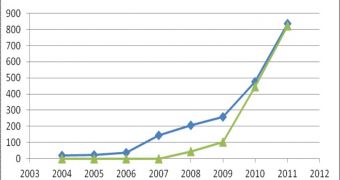Documents released by the United States Department of Justice in response to a freedom of information (FOI) request made by the American Civil Liberties Union (ACLU) reveals that the number of surveillance orders issued by authorities increased considerably over the past few years.
The figures show that back in 2001, there were only just over 5,500 pen register and trap and trace surveillance orders. However, in 2011, the number grew to 37,616.
One noteworthy thing is that pen register and trap and trace surveillance doesn’t target the content of communications such as emails or phone calls.
Pen registers capture outgoing data, and trap and trace devices collect incoming data. This means that the process records email addresses, possibly email subject lines, phone numbers, call durations and the times when they were made.
While authorities can’t obtain as much information as they do during a wiretap surveillance, the advantage of pen registers is that the legal standard for law enforcement is much lower.
“Specifically, in order to wiretap an American’s phone, the government must convince a judge that it has sufficient probable cause and that the wiretap is essential to an investigation,” ACLU’s Naomi Gilens explained.
“But for a pen register, the government need only submit certification to a court stating that it seeks information relevant to an ongoing criminal investigation. As long as it completes this simple procedural requirement, the government may proceed with pen register or trap and trace surveillance, without any judge considering the merits of the request.”
On the other hand, pen register surveillance isn’t the only one that skyrocketed in the past few years. We recently learned that mobile carriers from the United States received 1.3 million requests for subscriber information in 2011 alone.

 14 DAY TRIAL //
14 DAY TRIAL //